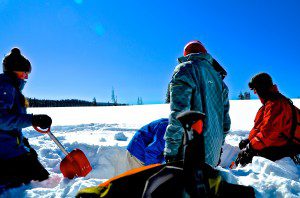28 Mar TELLURIDE MOUNTAIN SCHOOL INVESTIGATES LOCAL WATERSHED, PART THREE
Editor’s note: For two weeks, Telluride Mountain School High School students put aside textbooks and turned their attention to water. With the help of local experts on water and media, they researched, wrote, and presented everything there is to know about Telluride water– where it comes from, how it’s cleaned, and what the fate of future snowpack is. This third entry, by freshman Scout Engbring, is part three of a five-part series on Telluride water….
From Snowpack to River: A Look at Telluride’s Water Cycle
by Scout Engbring
Can you imagine living in a world where getting water to survive required most of our time and devotion? People living in wealthy communities have easy access to fresh, sanitary water. What most people don’t realize is how dramatically their lives would change if it weren’t so easy to get. In places like northern Africa, people have to walk mile upon mile just to get water that is suitable to drink.
Luckily for us, living in Telluride, water supply is not a problem. This is because we live in a place where we see on average 175.5 inches of snow fall per year in the winter. When you add up all of the space that gets covered in snow, it makes up 50 to 80 percent of Telluride’s water supply. Now, obviously some snow is denser than other snow, meaning it has more water content, but either way, it provides the majority of the water for Telluride.
The snow covers most of San Miguel County and drains into our filtration systems to be processed to its cleanest state. The town of Telluride gets its water from two main sources: from snowmelt after the winter, and rain during the summer. The snowmelt and the rain flow into Mill Creek and the Stillwell portal, where the water is retrieved for use.
Mill Creek, the main water supply, is located on the northwestern slope of the valley, up by the Jud Weibe trail. The water is channeled into a lake where it is left to settle. There, the water is sent through microfiltration systems that filter out the parasites and bacteria. Then chlorine is added for a final cleansing that gets it to a safe “turbidity,” which is a fancy term for the solid matter in the water.
The second source, the Stillwell Portal, is used more during the summer and is located high above the Jud Wiebe. This water is filtered differently, using something called a titanium oxide filter, which sucks the arsenic out of the water. The state law requires that water cannot have more than five parts per billion of arsenic. The water produced by these systems has half that, so it is confirmed as safe to drink. The water from the two places is combined and put into the pipes that supply the houses we live in.
We know that the average family of four uses up to 400 gallons of water a day. This may vary due to water access and number of people to a household. This number is combined with the water used by businesses in Telluride and water usage is also greatly increased by tourism. After it is consumed or used, the water flows through pipes out to the water treatment plant located at Society Turn. At this site, the water goes through many different systems and machines that make it somewhat clean. Every day, about 700,000 gallons of water are used. Out of this, 400,000 gallons are treated at this plant and put back into the cycle. The plant runs 24/7 and takes out the most toxic elements in the water.
Where does it go from there? Back into the San Miguel River, to start its cycle all over again. Although fresh water is easy to get for us living in Telluride, there is a lot of time and work put into making it drinkable. After it is used, there is even more work to be done to return the water to the cycle.
Check out this podcast with Miles Galbo to learn more about how to conserve water.
See all the photos and stories from the Telluride Mountain School water project here.




Sorry, the comment form is closed at this time.